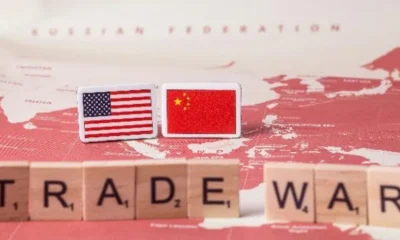Trends
The Dollar Row. Trump’s Warning To BRICS Amid Dollar’s Biggest Weekly Drop In A Year—Is The Dollar’s Reign At Risk?
Published
11 months agoon

With the dollar row, Donald Trump is back in the headlines, and this time he’s not mincing words.
In a fiery post on his social media platform, Truth Social, the U.S. President-elect issued a stern ultimatum to the BRICS nations—Brazil, Russia, India, China, and South Africa. His message? Don’t even think about dethroning the mighty U.S. dollar, or face tariffs so steep that it’ll make your heads spin.
Let’s break it down.
Trump’s warning came after last month’s BRICS summit in Kazan, Russia, where the bloc openly discussed moving away from the dollar in favor of local currencies. This isn’t just posturing; it’s a serious consideration that has rattled the U.S. economic establishment.
In Trump’s words, the idea that the U.S. would “stand by and watch” as BRICS shifts away from the dollar is, as he put it, “OVER.”
Why the Fuss?
For decades, the U.S. dollar has been the undisputed king of global trade. Whether you’re buying oil, gold, or microchips, chances are you’re dealing in dollars. But recently, cracks have been showing. Countries like China and Russia are advocating for a multipolar currency world, and the BRICS nations are exploring alternatives that could reduce their dependence on the dollar.
Trump’s aggressive stance—threatening 100% tariffs on BRICS exports—shows how much the U.S. values its dollar supremacy. Imagine the ripple effects if BRICS countries successfully implement a non-dollar trade system. Suddenly, the power dynamics of global trade shift, and the dollar loses its long-held dominance. For the U.S., that’s a nightmare scenario.
Trump’s Blunt Approach
“Go find another ‘sucker!’” Trump declared, reinforcing his no-nonsense message. He also warned that any country supporting the dethroning of the dollar should prepare to “wave goodbye to America.” His approach is classic Trump: confrontational, bold, and aimed at stirring up both fear and loyalty.
But let’s not forget the broader context. This isn’t just Trump being Trump. The U.S. dollar has seen its biggest weekly drop in a year, raising concerns about its long-term stability. The BRICS nations, collectively representing over 40% of the global population and nearly 25% of the world’s GDP, wield considerable influence. Their collective move to weaken the dollar’s dominance could reshape the global economic dynamics completely!
Will BRICS Back Down?
That’s the billion-dollar question. While the U.S. market is crucial to BRICS countries, their growing economic clout gives them leverage. China and Russia, in particular, have been vocal about their desire to reduce dollar dependency. India, though cautious, is also open to exploring alternative trade systems.
Trump’s threat of 100% tariffs is a powerful deterrent, but BRICS might see this as the push they need to accelerate their plans. After all, nobody likes being strong-armed, especially on the international stage.
Dollar Dips. Biggest Weekly Loss in a Year—What’s Going On?
Meanwhile, the U.S. dollar is having a rough week, sliding to its lowest point in a year. After months of riding high on expectations that Donald Trump’s policies would boost the greenback, reality seems to be kicking in. Bloomberg’s dollar index dropped 0.4% on Friday, capping a 1.3% decline for the week. The yen is loving it, jumping 3.5% against the dollar as speculation builds that the Bank of Japan might raise interest rates next month.
Why the Sudden Drop?
“The dollar was bound to cool off,” says Brad Bechtel, global head of FX at Jefferies. Since Trump’s election, the dollar soared on excitement over his aggressive economic plans, but it looks like it went too far, too fast. “The euro, yen, and pound had been undervalued compared to where they should be based on real rate differences, and now we’re seeing a correction,” Bechtel explains.
A big reason for the pullback? Trump’s recent pick for Treasury Secretary—hedge fund veteran Scott Bessent. Unlike the more radical figures some had anticipated, Bessent’s nomination signaled a steadier, more traditional economic approach. That cooled off some of the dollar hype, as traders dialed back their aggressive bets on a dramatic shift in U.S. policy.

Tariffs, Inflation, and Speculation—Oh My!
Before this week, the dollar had been climbing on the belief that Trump’s plans for steep tariffs could reignite inflation, forcing the Federal Reserve to shift away from its rate-cutting stance. Traders were piling into long-dollar positions, betting the greenback would keep climbing. But now, with Bessent in the mix and a more cautious tone from the incoming administration, they’re pulling back.
“Traders have been going long on the dollar against major currencies since mid-October, fueled by election risk and Trump’s policy talk,” says one market watcher. “Now that we’re seeing the actual nominations, they’re easing off those bets.”
BRICS 2024. Is the Dollar’s Reign at Risk?
At the 2024 BRICS Summit, Russian President Vladimir Putin didn’t hold back. He called out the U.S. for what he described as the “weaponization of the dollar,” a strategy he believes is a serious mistake.
“The dollar is being used as a weapon. We really see that this is so,” Putin stated. His comments reflect growing frustration among BRICS members—Brazil, Russia, India, China, and South Africa—who are increasingly looking for ways to reduce their dependence on the U.S. dollar in global trade.
Russia and China Lead the Charge
Putin stated that nearly 95% of trade between Russia and China now happens in rubles and yuan, cutting the dollar out of the equation. On top of that, Russia is reportedly developing an alternative to the Belgium-based SWIFT payment system, although progress has been slow.
The idea of a single BRICS currency has also been floated, with Russia even unveiling a prototype BRICS banknote. While it’s more concept than reality right now, the fact that it’s being seriously discussed signals a shift. Whether it’s a central bank digital currency, a stablecoin, a basket of BRICS currencies, or even one backed by gold and silver, the notion of a future alternative to the dollar is no longer just wishful thinking.
Mixed Signals from BRICS Leaders
Despite the bold ideas, Putin clarified that neither a unified BRICS currency nor a full-blown SWIFT alternative is imminent. “As for SWIFT and any alternatives, we have not created and are not creating any alternatives,” he said. On a potential BRICS currency, he added, “We are not considering that question at the moment.”
Still, the BRICS Cross-Border Payments Initiative—a framework aimed at strengthening correspondent banking networks and enabling settlements in domestic currencies—shows there’s genuine interest in reducing reliance on the dollar, even if progress is incremental.
The BRICS bloc—Brazil, Russia, India, China, and South Africa—has been at the forefront of this movement. In 2023, BRICS expanded by welcoming six new members: Argentina, Egypt, Ethiopia, Iran, Saudi Arabia, and the UAE. Together, these countries now represent about 40% of the global population, making their push for a less dollar-centric world harder to ignore.
De-Dollarization: Reality or Hype?
The buzz around “de-dollarization” is growing. China has started using the yuan in commodity trades with some partners, and Brazil and Argentina are exploring a common currency. These moves have sparked speculation that the U.S. dollar could lose its position as the world’s dominant reserve currency.
But let’s pump the brakes. While diversification in global currencies may be on the rise, jumping from dollar dominance to full-scale de-dollarization is a stretch. The U.S. dollar still holds unmatched trust and liquidity in global markets, and it’ll take more than a few bilateral agreements to change that overnight.
What Happens if the Dollar Loses Its Reserve Currency Status?
To understand the possibility, we need to look at how the dollar became the world’s go-to currency and why some countries want to change that.
For centuries, there’s always been a dominant currency that handled the majority of global trade. Historically, this role has shifted between European colonial powers like Spain, France, and England. These currencies were often backed by precious metals, usually gold, along with the power of the state behind them.
Fast forward to the early 20th century: After World War I, the British economy struggled, and much of the world’s gold moved from London to New York. By the 1920s, the U.S. was booming, and its dominant role in World War II solidified New York as the world’s financial hub. In 1944, the Bretton Woods Agreement officially crowned the U.S. dollar as the world’s reserve currency, replacing the British pound.
Then came 1971. President Richard Nixon took the U.S. off the gold standard, meaning the dollar was no longer tied to precious metals. From that point on, the dollar was backed solely by the “full faith and credit” of the U.S. government. Since then, there have been countless predictions about the end of the dollar’s dominance.

Why the Dollar Still Reigns Supreme
There are several reasons why the U.S. dollar continues to dominate as the world’s reserve currency, but one of the biggest is the petrodollar system. Most of the world’s oil transactions happen in dollars, and since energy is a global necessity, this fuels a massive, ongoing demand for the greenback.
But oil isn’t the only factor. There’s a broader need for a common currency in international trade. Imagine a Brazilian farmer selling soybeans to a Japanese company. It’s unlikely the Japanese buyer will have Brazilian reals on hand, and the Brazilian farmer probably doesn’t want to be paid in yen.
The simplest solution? Convert yen into dollars, make the transaction, and then convert those dollars into reals. This reliance on the dollar as a middleman keeps it central to global trade.
According to Federal Reserve data, between 1999 and 2019, the dollar was used in 96% of trade transactions in the Americas, 74% in Asia, and 79% globally. It also plays a key role in banking, accounting for about 60% of non-domestic deposits and loans worldwide. In the foreign exchange market, the dollar is involved in nearly 90% of all trades.
Why No Other Currency Has Taken Over
Over the years, there’s been plenty of talk about replacing the dollar. The euro once seemed promising, but the 2008 financial crisis and ongoing political and economic turbulence in Europe dented its credibility. Japan’s yen is stable, but its stagnant economy and aging population make it an unlikely candidate. And while China’s yuan is growing in prominence, strict government controls on capital flow make it less appealing as a reserve currency.
Other currencies, like the Swiss franc, are stable but tied to economies too small to support the massive capital flows a global reserve currency requires.
The Push for De-dollarization
The push to find alternatives to the dollar gained traction in 2022 after the U.S. imposed heavy sanctions on Russia following its invasion of Ukraine. The sanctions froze Russia’s funds, raising concerns among other nations about the U.S. wielding too much power over global finances.
Inflation has also shaken confidence in the dollar. For decades, the U.S. maintained low, stable inflation, giving global investors a sense of security. But in recent years, inflation has soared, prompting some countries to rethink their reliance on the dollar for long-term savings and investments.
In response, nations like China, India, and Brazil have begun exploring ways to trade directly in their own currencies, reducing the dollar’s dominance and creating a more multipolar financial system.
Is De-Dollarization on the Horizon?
The good news for Americans? The dollar has held its ground surprisingly well, even with rising U.S. debt and inflation concerns. Over the past five years, the U.S. Dollar Index is up 6.6%. However, the last six months have shown a slight dip of about 0.7%, raising questions about where it’s headed next.
Bank of America economist Claudio Irigoyen recently shed light on international concerns over the U.S.’s ballooning debt. While a default is unlikely, there’s a growing fear that the U.S. might manage its debt by letting inflation eat away at its value.
“If the U.S. moves to a point where the preferred policy is one of financial repression that allows debt to be inflated away, the market will start wondering about alternatives to the dollar as a store of value,” Irigoyen noted.
Gold and Bitcoin: Alternatives or Outliers?
Gold has surged nearly 81% over the last five years, almost keeping pace with the S&P 500. For some, this signals trouble for the dollar. But as Irigoyen points out, there simply isn’t enough gold in circulation to replace the dollar without causing significant deflationary issues.
On the more radical side, Bitcoin has entered the conversation. With its fixed supply and growing mainstream acceptance, Bitcoin could absorb a portion of global central bank reserves. El Salvador’s move to adopt Bitcoin as legal tender in 2021 was a bold step, and the U.S. launching its first spot Bitcoin ETFs in early 2024 has added credibility to the cryptocurrency.
Yet, Irigoyen notes that even though the dollar’s share in global reserves has dropped by 10 percentage points over the past two decades, no other currency has made significant gains. Instead, central banks are diversifying into currencies from smaller economies like Australia and Canada.
The Last Bit.
Could the 2020s Be a Turning Point?
Calls for the end of the dollar’s reign aren’t new, but they’re louder now than ever. The pandemic reshaped global trade, and emerging economies are seeking more control over their financial systems. While the dollar remains the world’s most trusted currency, the idea of a shift is no longer far-fetched.
But is the dollar really on the verge of losing its throne? It’s hard to say. Reserve currencies don’t lose their status overnight. However, with more countries pushing to diversify their trade currencies, the world might be inching closer to a more balanced financial system where the dollar shares the stage with others.
For now, the greenback is still king—but how long it stays that way is the real question.
You may like
-


Taiwan’s ‘Historic’ TSMC Deal, A Win Or The End Of Its ‘Silicon Shield’ As China Threatens? A Jittery Taiwan Watches Trump’s Moves On Ukraine, Wondering, Could We Be Next?
-


A Trade War That Just Won’t Quit. As Trump’s Tariffs Hit, China Stays The Course, For Xi’s Its Business As Usual Strategy
-


Indian Stock Market In Turmoil. Investors In Panic Mode, Is This A Temporary Correction Or The Start Of A Bear Market?
-


America And China’s Thirst For Gold In 2025 Is Draining Other Countries’ Reserves; Here’s Why?
-


Shakeup In The Auto Sector. Mercedes-Benz 15% Job Cuts, Nissan CEO Exit, And Germany’s Make-Or-Break Year
-


DeepSeek Ai Rush. China’s AI Contender Gears Up for Next Big Launch Even As It Gets Xi Jinping’s Blessings
